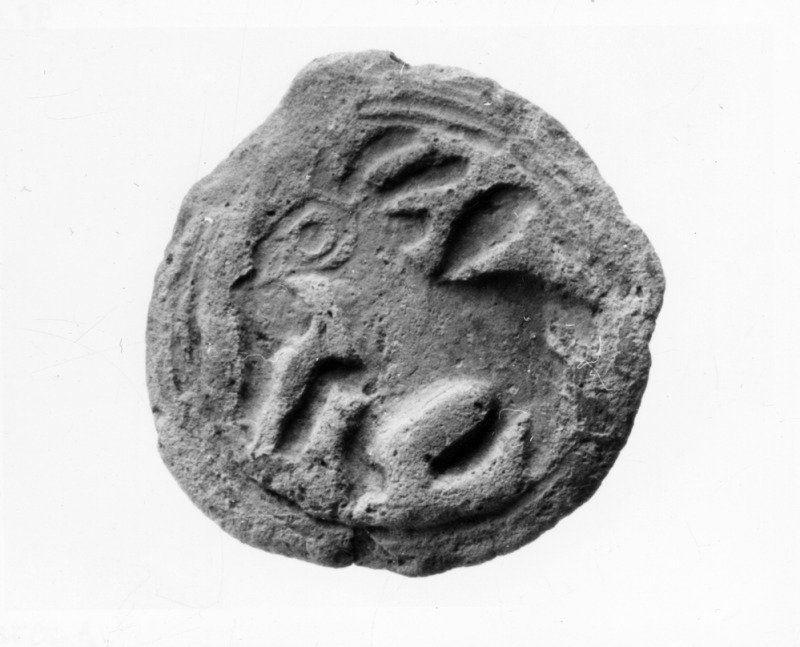
Coptic stamp
Classical Antiquities
| Date | early 3rd century A.D. |
|---|---|
| Object type | relief |
| Medium, technique | carved, limestone |
| Dimensions | 46 × 53.8 cm |
| Inventory number | 2004.1.A |
| Collection | Classical Antiquities |
| On view | Museum of Fine Arts, Basement Floor, Classical Antiquity, Eros – Dionysos – Thanatos |
Palmyra, the largest oasis of the Syrian Desert, lies halfway between the Mediterranean Sea and the River Euphrates. It is inhabited since the 7th millennium BC. Owing to its bountiful springs and the surrounding plain, which provided its inhabitants with a rich livelihood, Palmyra steadily grew in importance in the Hellenistic age (3rd–1st century B.C.), becoming the most significant settlement on the desert routes leading to the Euphrates, as well as a hub of ancient intercontinental relationships. From there one could reach India and China both by land (along the Silk Road) and by sea (across the Persian Gulf). Through its luxury commerce, which yielded an estimated hundredfold profit, Palmyra achieved almost unimaginable wealth.
At the end of the Hellenistic age the city was under Roman rule. It reached the zenith of its power in the middle of the 2nd century A.D. From 230 it played a prominent part in the war between two giant empires, Rome and Sassanid Persia. The ancient history of Palmyra ended with the Arab conquest in 634. Its rediscovery began only in the 17th century, when its ruins first amazed European visitors. Palmyra was all the more attractive since its culture was both familiar and alien: it presented completely unique versions of motifs known from Greek and Roman art and architecture. Palmyra was established at the meeting point of two worlds: the Mediterranean and the Orient. Not only was its population mixed (Aramaeans Arabs, Greek and Roman), but also its religion (besides the temples of Greek, Roman and Syrian gods, it had a synagogue and a Christian church) and its language, as well. The Graeco-Roman elements defining Palmyrean art attest the ability of classical culture to provide other civilizations with artistic forms for the expression of their own ideas. Similarly, Palmyra took only what it felt to be valid from the vast offerings flowing in from the West.
This limestone relief is an excellent example of the intercultural character of Palmyrean art. The main figure is a man lying on an ornate bed and holding a cup in his left hand. He is wearing the typical Parthian attire of his time: sandals, trousers (the folds are seen above the sandals) and a splendidly woven garment. A mantle is wrapped around his waist in Greek fashion. A woman is sitting at his feet on a pair of cushions; she is wearing a chiton and earrings. Her mantle is fastened with a round fibula, and her left hand pulls her shawl, wrapped around her head, before her face in a typical gesture of mourning. Between the two figures there is a young man in Greek clothing, resting his left hand on the shoulder of the man as a sign of affection. An Aramaic inscription runs on both sides of the figure of the young man, naming the figures.
The relief was the funerary stele of a couple. In harmony with the social concepts of the age, it is the husband who appears as the protagonist of the scene. The deceased banqueting surrounded by his loved ones was the emblematic expression of a manly life in Antiquity, irrespective of time and place-be it Hellas, Italy or Mesopotamia. Thus the relief might have offered a message equally acceptable for viewers familiar with the Greek symposion, Latin convivium, or the marzeah widespread in oriental cultures.
Collective tombs are quite characteristic of the necropoli of Palmyra. Above ground the tomb complexes were marked by towers or (in subsequent periods) had house-like superstructures. The subterranean sections cut into the rocks had galleries opening into each other, the walls of which were lined with pre-cut niches, much like catacombs. The dead were interred in these niches, which were then closed using rectangular limestone reliefs. In all probability the Budapest stele had such a function. Based on its style, the form of the letters, and other, analogous examples, the Budapest stele is datable to the beginning of the 3rd century.
Following ÁRPÁD MIKLÓS NAGY
This record is subject to revision due to ongoing research.